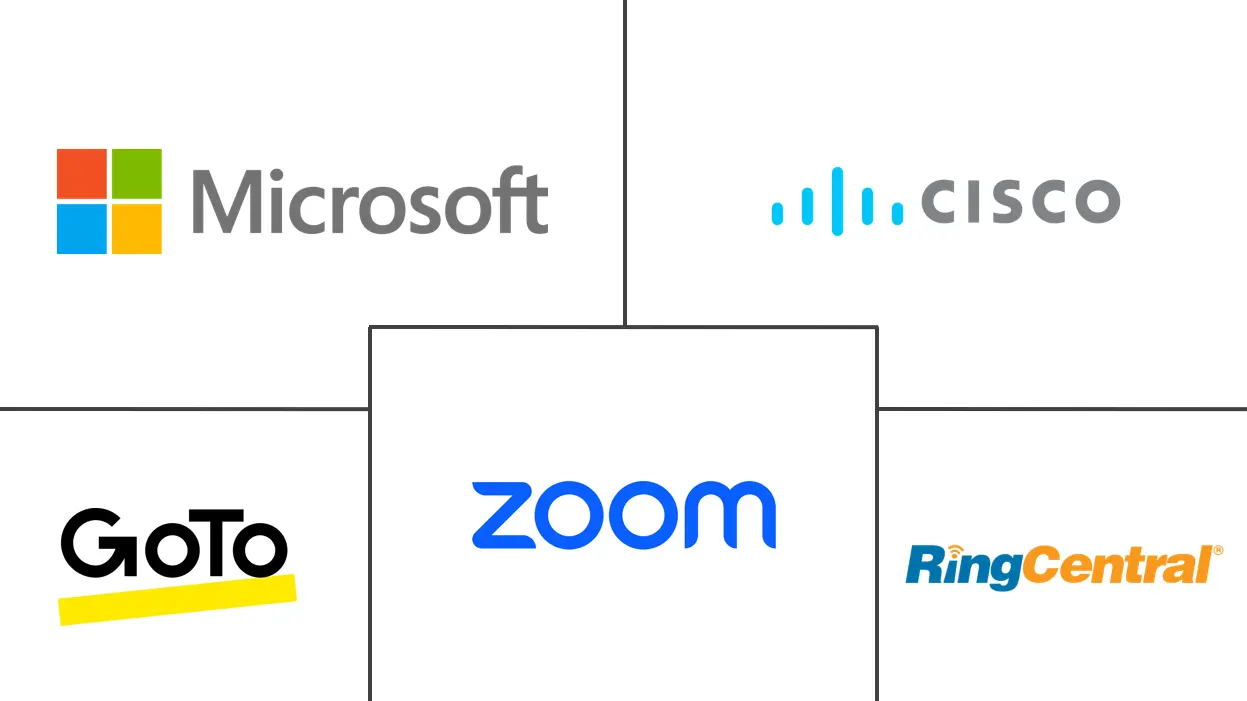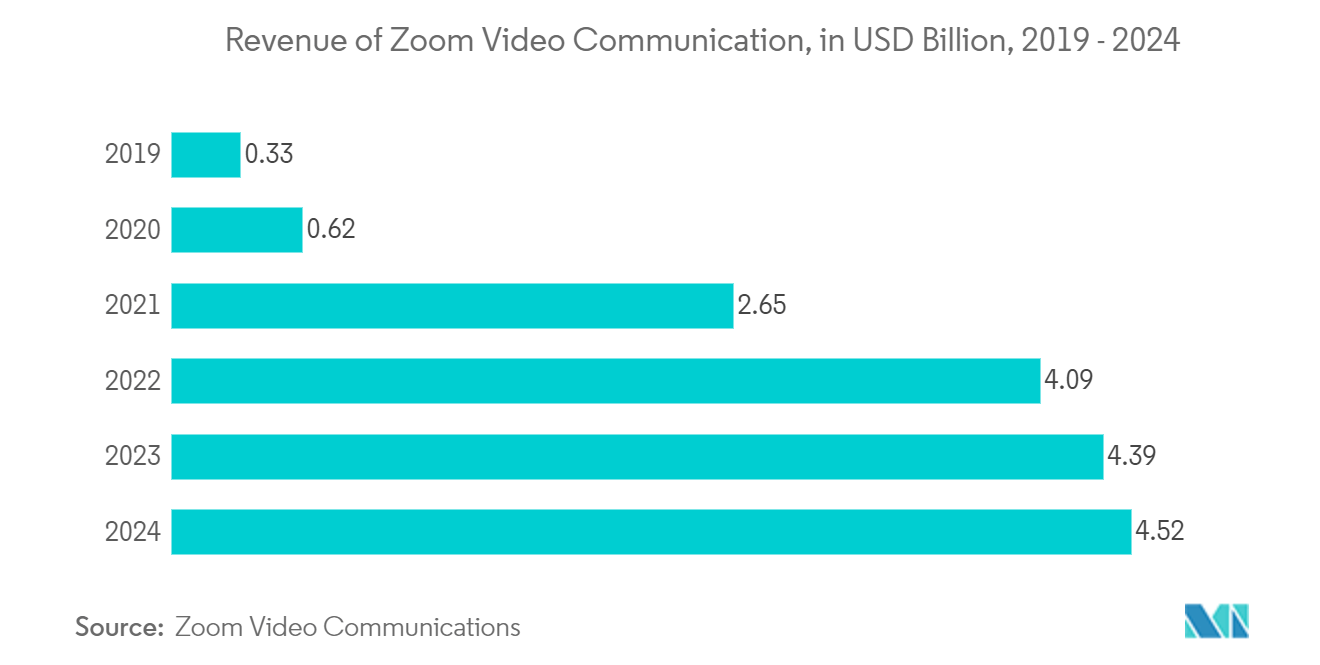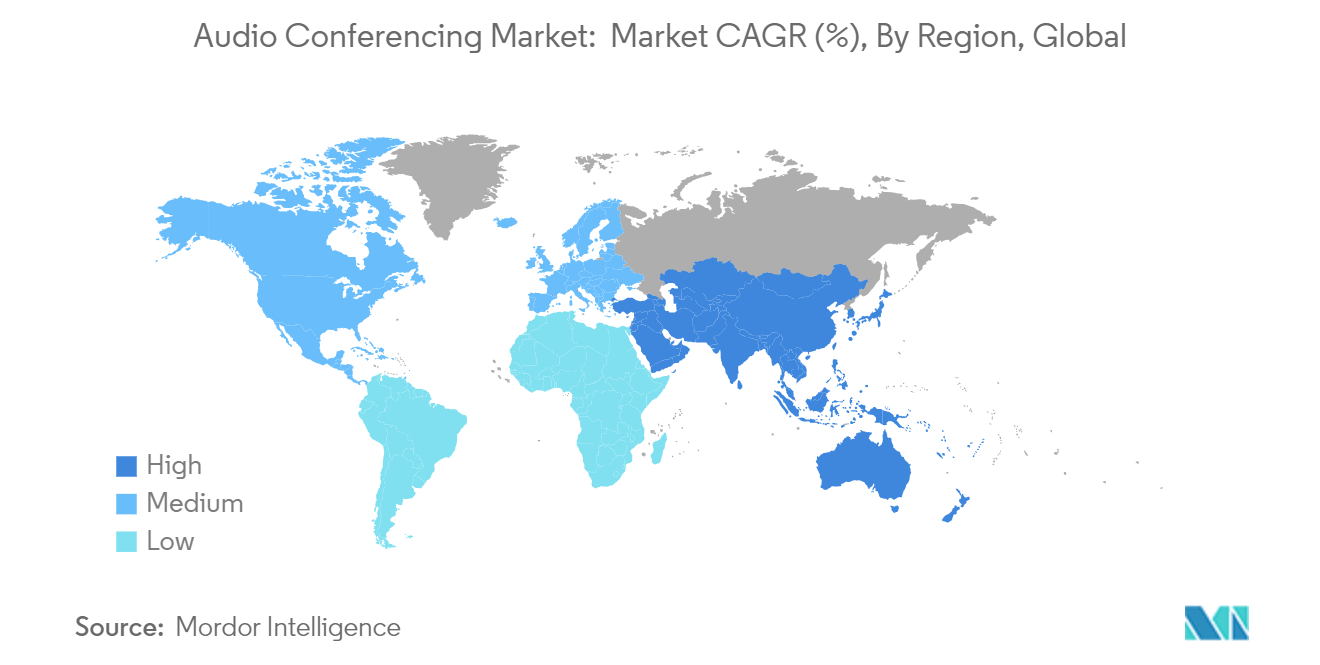Audio Conferencing Market Size

| Study Period | 2019 - 2029 |
| Market Size (2024) | USD 19.10 Billion |
| Market Size (2029) | USD 29.46 Billion |
| CAGR (2024 - 2029) | 9.06 % |
| Fastest Growing Market | Asia Pacific |
| Largest Market | North America |
Major Players
*Disclaimer: Major Players sorted in no particular order |
Audio Conferencing Market Analysis
The Audio Conferencing Market size is estimated at USD 19.10 billion in 2024, and is expected to reach USD 29.46 billion by 2029, growing at a CAGR of 9.06% during the forecast period (2024-2029).
- A significant trend in the audio-conferencing market is incorporating audio-conferencing features into comprehensive Unified Communications platforms. Businesses gravitate towards solutions that merge audio, video, messaging, and collaboration tools into a cohesive interface. This shift is fueled by a quest for streamlined communication and an ambition to boost productivity by minimizing the number of distinct tools employees rely on.
- The audio-conferencing market is witnessing a swift embrace of cloud technology. Cloud-based conferencing solutions outshine traditional on-premises systems in terms of scalability, flexibility, and cost-effectiveness. This transition empowers businesses to swiftly roll out and oversee conferencing services, all while making minimal infrastructure investments—a proposition especially enticing for SMEs.
- There's a growing infusion of artificial intelligence into audio conferencing tools. Features like real-time transcription, noise cancellation, and voice recognition powered by AI are elevating user experience and bolstering accessibility. Furthermore, automation is being harnessed to simplify scheduling, engage participants, and deliver analytics, enabling organizations to maximize their conferencing tool utilization.
- In 2024, Google rolled out its "adaptive audio" feature for Google Meet. This innovation allows the platform to automatically identify multiple laptops in a single room, seamlessly merging their speakers and microphones. The goal is to ensure that all participants are clearly heard, eliminating the need to gather around one laptop while also minimizing echoes and audio feedback.
- The market faces several challenges. It's highly competitive, with many players offering similar features, making differentiation a tough task. Moreover, as hybrid work models gain traction, companies grapple with delivering a consistent experience for both in-office and remote employees.
- The audio-conferencing market underwent a significant transformation due to the macroeconomic shock of the COVID-19 pandemic. Lockdowns led to an unprecedented spike in demand for audio conferencing solutions as businesses sought to uphold communication and collaboration without in-person meetings. In the post-pandemic world, factors like the globalization of businesses, evolving remote/hybrid work trends, and the need for efficient cross-border communication are anticipated to continue to fuel the demand for audio conferencing solutions.
Audio Conferencing Market Trends
Corporate Communication Segment to Drive Opportunities in the Market
- Seamless communication channels are essential for businesses, whether they're SMEs or large multinationals, to operate efficiently. With the growing adoption of hybrid and remote work models, the demand for robust audio-conferencing tools has surged. These tools empower companies to uphold productivity, foster team collaborations, and facilitate decision-making, irrespective of physical location.
- In the corporate sector, a prevailing trend has emerged: employees are dedicating their time both in-office and remotely. Audio conferencing serves as a vital link, facilitating seamless communication between in-office and remote workers. The Flex Index Report 2024 highlights that 38% of US companies have adopted a Structured Hybrid model, while 33% mandate Full-Time In-Office attendance for corporate employees, and 29% offer a Fully Flexible arrangement.
- In 2023, Microsoft reported that its Teams platform boasted 320 million monthly active users. Teams have become a pivotal platform for corporations globally. Meanwhile, Zoom, a leading player in the virtual meeting arena, saw its revenue surge, culminating in a noteworthy USD 4.52 billion in FY 2024. Other virtual meeting platforms are also reaping the benefits, consistently growing both in revenue and monthly user counts.
- Companies are on the hunt for integrated solutions that meld audio conferencing with collaboration tools like instant messaging, audio/video conferencing, and project management solutions. Furthermore, the corporate sector is increasingly embracing the integration of artificial intelligence into audio conferencing.
- AI-driven functionalities, including real-time transcription, language translation, and voice recognition, are amplifying the usability and accessibility of these tools, rendering them invaluable to a diverse workforce. Take Dialpad, for example, it provides automated post-meeting summaries and transcriptions, making it an excellent choice for teams under 100 seeking these AI-enhanced features.

Asia Pacific Region is Witnessing Significant Growth in Demand
- Businesses across diverse sectors in the APAC region are rapidly embracing new technologies, signaling a swift digital transformation. This trend in digitization is propelling the uptake of audio-conferencing solutions as companies aim to bolster communication and collaboration.
- Historically, remote work wasn't prevalent in Asia, but the pandemic has catalyzed a pronounced shift towards hybrid work models across numerous APAC nations. Data from Statistics Korea highlights this change: remote workers surged to 683,000 in 2023 from just 94,000 in 2019 in South Korea. This shift underscores a broader trend, with organizations increasingly endorsing flexible work arrangements that blend home and office settings.
- In nations like India, China, and across Southeast Asia, small and medium-sized enterprises (SMEs) are witnessing rapid growth. The Ministry of Micro, Small, and Medium Enterprises (India) reports around 40 million registered MSMEs in India alone. As these SMEs increasingly adopt audio conferencing tools, they enhance communications with clients, suppliers, and remote staff, further fueling the market's expansion.
- In the region, educational institutions are increasingly adopting audio conferencing technologies for virtual classrooms, online training, and remote learning. Countries such as India, China, and Japan are witnessing a surge in the use of these tools, driven by a demand for more flexible and accessible learning environments.
- The rollout of 5G networks in the region is poised to revolutionize the audio-conferencing market. With 5G's enhanced bandwidth, reduced latency, and superior connectivity, users can expect higher quality audio and more dependable connections, especially those on mobile or remote. This advancement is set further to accelerate the adoption of audio-conferencing solutions throughout the region.

Audio Conferencing Industry Overview
The audio-conferencing market is moderately competitive and driven by increasing demand for remote communication solutions. Major players like Zoom, Microsoft Team, and Cisco Webex dominate with robust, integrated platforms, while smaller providers strive to differentiate themselves through unique features or cost-effective pricing. In addition, the rise of advanced technology-based solutions and the entry of new players intensify competition.
Considering the growing economic growth of the developing region, driven by expanding commercial and industrial activities, audio conferencing technology is set to gain traction. Vendors in the market should focus on developing solutions that consider regional requirements and market dynamics. Furthermore, expanding direct presence in emerging markets is also anticipated to remain among the vendors' key strategic priorities. It will help them better track the market dynamics and adjust their strategies accordingly.
Audio Conferencing Market Leaders
-
Zoom Video Communications, Inc.
-
Microsoft Corporation
-
Cisco
-
GoTo
-
RingCentral, Inc
*Disclaimer: Major Players sorted in no particular order

Audio Conferencing Market News
- June 2024: Nureva Inc., a pioneer in advanced audio conferencing solutions, has received certification for its HDL310 and HDL410 systems as professional audio devices tailored for larger Zoom Rooms. Being USB devices, the HDL pro series systems seamlessly integrate into the design of any larger Zoom-enabled environment, be it classrooms, boardrooms, or training spaces. These systems feature one or two wall-mounted microphones and speaker bars paired with a compact connect module.
- January 2024: Google announced that Microsoft Teams is coming to Android Auto. Android Auto, an app that enables Android phones to connect to a car’s built-in system, was anticipated to introduce Microsoft’s communication and collaboration platform in February 2024.
- March 2024: Cisco introduced the Cisco Desk Phone 9800 Series, which aims to provide seamless and personalized collaboration experiences that are adaptable for both on-prem and cloud calling platforms. Moreover, it enhances every desk with enterprise calling features, including premium audio and AI-driven noise removal.
Audio Conferencing Market Report - Table of Contents
1. INTRODUCTION
- 1.1 Study Assumptions and Market Definition
- 1.2 Scope of the Study
2. RESEARCH METHODOLOGY
3. EXECUTIVE SUMMARY
4. MARKET INSIGHTS
- 4.1 Market Overview
-
4.2 Industry Attractiveness - Porter's Five Forces Analysis
- 4.2.1 Bargaining Power of Suppliers
- 4.2.2 Bargaining Power of Consumers
- 4.2.3 Threat of New Entrants
- 4.2.4 Threat of Substitutes
- 4.2.5 Intensity of Competitive Rivalry
- 4.3 An Assessment of Impact of Macroeconomic Trends on The Market
5. MARKET DYNAMICS
-
5.1 Market Drivers
- 5.1.1 Remote Work Adoption
- 5.1.2 Globalization of Businessess
-
5.2 Market Restraints
- 5.2.1 Security Concerns
6. MARKET SEGMENTATION
-
6.1 By Component
- 6.1.1 Hardware
- 6.1.2 Software
- 6.1.3 Service
-
6.2 By End User Vertical
- 6.2.1 Corporate Communication
- 6.2.2 Education
- 6.2.3 Government
- 6.2.4 Others
-
6.3 By Geography***
- 6.3.1 North America
- 6.3.2 Europe
- 6.3.3 Asia
- 6.3.4 Australia and New Zealand
- 6.3.5 Latin America
- 6.3.6 Middle East and Africa
7. COMPETITIVE LANDSCAPE
-
7.1 Company Profiles
- 7.1.1 Zoom Video Communications, Inc.
- 7.1.2 Microsoft Corporation
- 7.1.3 Cisco
- 7.1.4 GoTo
- 7.1.5 RingCentral, Inc
- 7.1.6 Grandstream Networks, Inc.
- 7.1.7 Google LLC (Alphabet Inc)
- 7.1.8 Dialpad Inc.
- 7.1.9 Avaya LLC
- 7.1.10 Philips Dictation
- 7.1.11 Vonage (Ericsson)
- 7.1.12 ZipDX LLC
- 7.1.13 Mitel Networks Corporation
- *List Not Exhaustive
8. INVESTMENT ANALYSIS
9. FUTURE OF THE MARKET
** Subject To AvailablityAudio Conferencing Industry Segmentation
Audio conferencing is a communication method that enables multiple participants to engage in real-time voice conversations from different locations. It utilizes telecommunication technologies such as traditional phone lines (PSTN) or internet-based systems (VoIP), allowing individuals or groups to connect for meetings, discussions, or collaboration without being physically present.
The study tracks the revenue generated from selling audio conferencing products and solutions by various companies worldwide. It also tracks the key market parameters, underlying growth influencers, and major manufacturers operating in the industry, which supports the market estimations and growth rates over the forecast period. The study further analyses the overall impact of macroeconomic factors on the market. The report’s scope encompasses market sizing and forecasts for the various market segments.
The audio-conferencing market is segmented by component (hardware, software, service), by end-user vertical (corporate communication, education, government, others), and by geography (North America, Europe, Asia-Pacific, and Rest of the World). The market sizes and forecasts are provided in terms of value (USD) for all the above segments.
| By Component | Hardware |
| Software | |
| Service | |
| By End User Vertical | Corporate Communication |
| Education | |
| Government | |
| Others | |
| By Geography*** | North America |
| Europe | |
| Asia | |
| Australia and New Zealand | |
| Latin America | |
| Middle East and Africa |
Audio Conferencing Market Research FAQs
How big is the Audio Conferencing Market?
The Audio Conferencing Market size is expected to reach USD 19.10 billion in 2024 and grow at a CAGR of 9.06% to reach USD 29.46 billion by 2029.
What is the current Audio Conferencing Market size?
In 2024, the Audio Conferencing Market size is expected to reach USD 19.10 billion.
Who are the key players in Audio Conferencing Market?
Zoom Video Communications, Inc., Microsoft Corporation, Cisco, GoTo and RingCentral, Inc are the major companies operating in the Audio Conferencing Market.
Which is the fastest growing region in Audio Conferencing Market?
Asia Pacific is estimated to grow at the highest CAGR over the forecast period (2024-2029).
Which region has the biggest share in Audio Conferencing Market?
In 2024, the North America accounts for the largest market share in Audio Conferencing Market.
What years does this Audio Conferencing Market cover, and what was the market size in 2023?
In 2023, the Audio Conferencing Market size was estimated at USD 17.37 billion. The report covers the Audio Conferencing Market historical market size for years: 2019, 2020, 2021, 2022 and 2023. The report also forecasts the Audio Conferencing Market size for years: 2024, 2025, 2026, 2027, 2028 and 2029.
Audio Conferencing Industry Report
Statistics for the 2024 Audio Conferencing market share, size and revenue growth rate, created by Mordor Intelligence™ Industry Reports. Audio Conferencing analysis includes a market forecast outlook for 2024 to 2029 and historical overview. Get a sample of this industry analysis as a free report PDF download.



